The sinking of the Titanic in 1912 is a well-known tragedy in history that affected more than just those who were on the ship. For people researching their family history, even if their ancestors weren’t part of the tragedy, this event can help you understand the broader world your ancestors lived in, from how people traveled and worked to how they reacted to major news.
To help you gain a better understanding of the Titanic disaster, I’ve compiled a list of more than 20 carefully curated articles that provide in-depth information and unique perspectives on the sinking of the Titanic. Use them to enhance your research or just learn more about the tragic disaster in 1912.
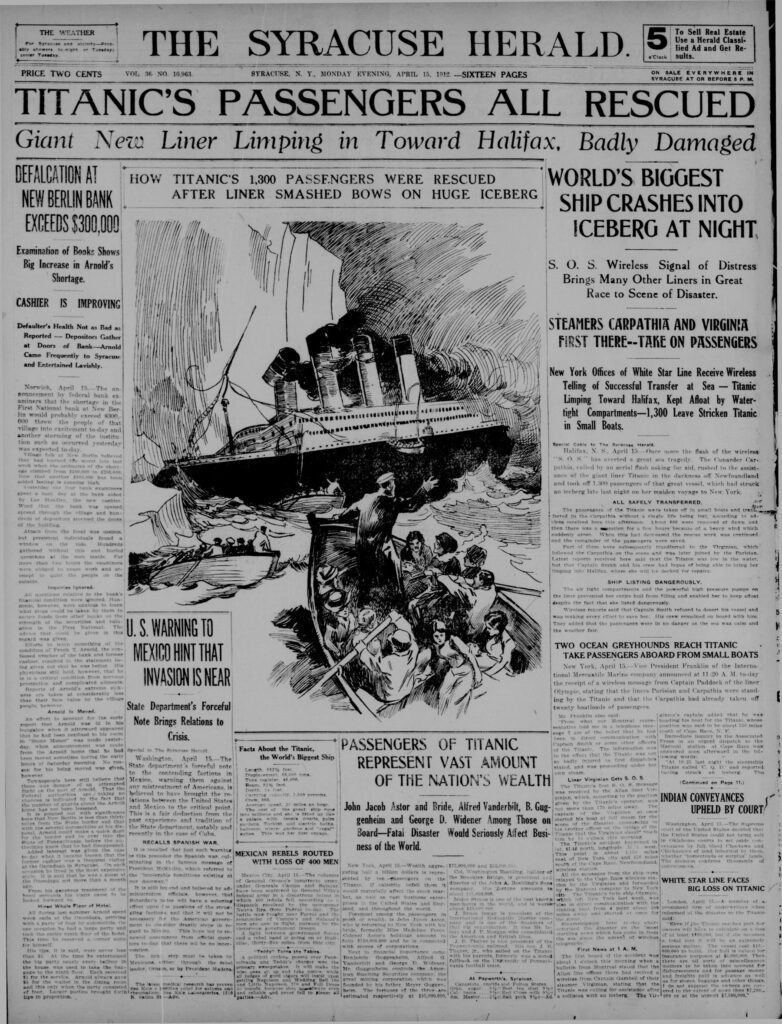
“Titanic’s Passengers All Rescued.”
The Syracuse Herald, April 15, 1912
- Initial Rescue Reports: The headline incorrectly states that all of Titanic’s passengers were rescued, with the ship limping toward Halifax after being badly damaged. This reflects the early confusion and misinformation during the immediate aftermath of the disaster.
- Impact and Response: The article notes that the world’s biggest ship, the Titanic, crashed into an iceberg at night and sent out an SOS wireless signal of distress, prompting many other liners to race to the scene for rescue efforts. It highlights the international response to the disaster.
- Wealth and Prominent Passengers: The page emphasizes the significant amount of wealth represented by the passengers on the Titanic, mentioning notable individuals such as John Jacob Astor, Alfred Vanderbilt, and Benjamin Guggenheim among those on board. It underscores the potential economic impact of the disaster on the world’s business.
“Horrible loss of life is admitted by White Star Line officials when first wireless message is received from commander of the ship with rescued ones on board.”
The Anaconda Standard, April 16, 1912
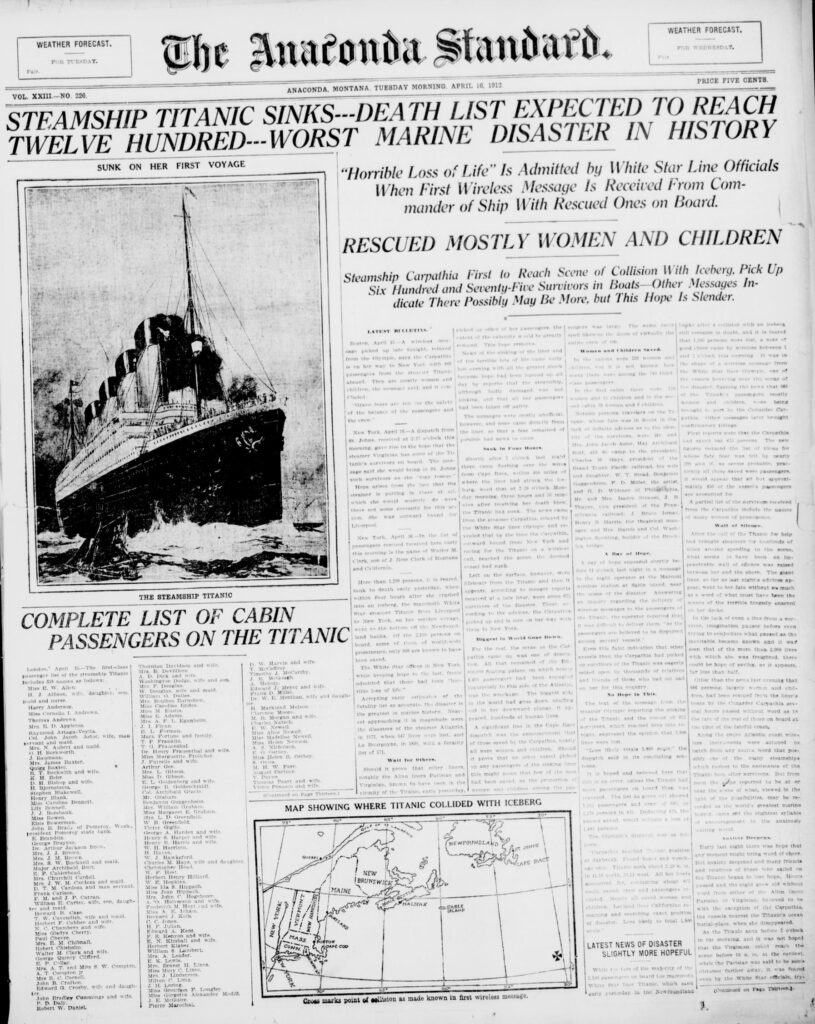
- Sinks on First Voyage: The death toll was expected to reach 1,200, making it the worst marine disaster in history at that time.
- Rescued Survivors: Most of the rescued were women and children. The steamship Carpathia picked up 675 survivors in lifeboats.
- Passenger List and Collision Map: The page includes a complete list of cabin passengers on the Titanic and a map showing where the Titanic collided with the iceberg.
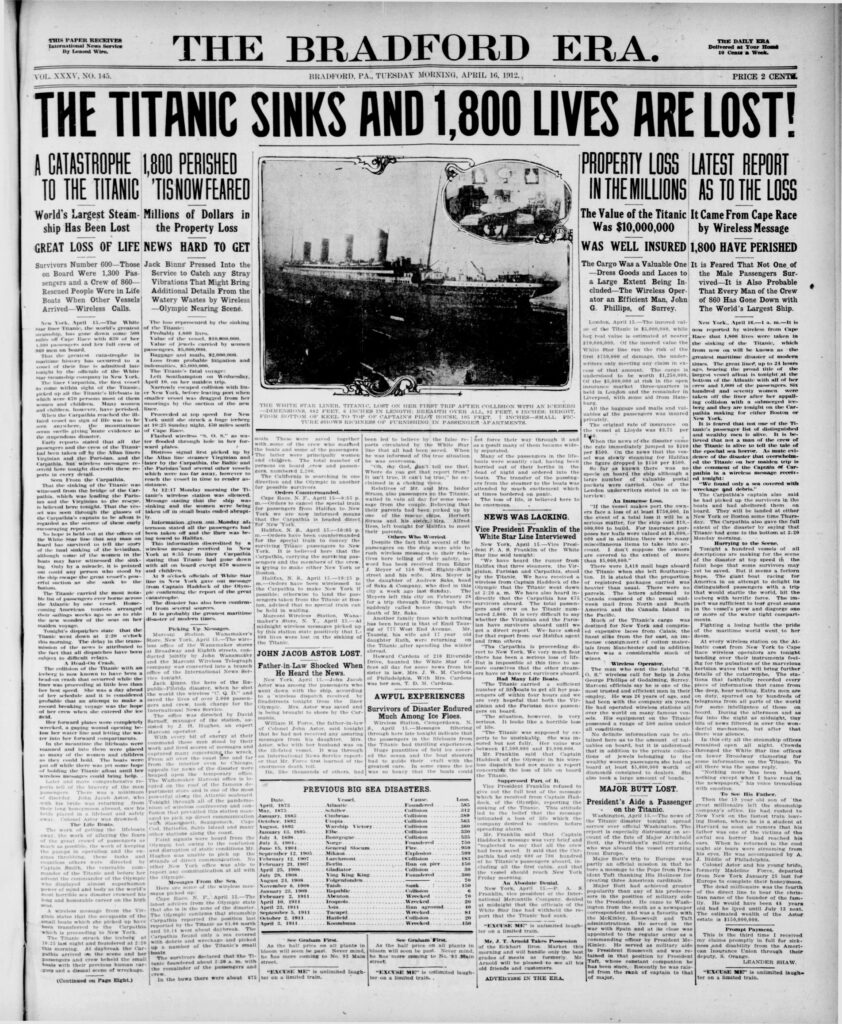
“It is feared that not one of the male passengers survived – it is also probable that every man of the crew of 860 has gone down with the world’s largest ship.”
The Bradford Era, April 16, 1912
- Massive Loss of Life: The headline reports that 1,800 lives were lost when the Titanic sank, emphasizing the magnitude of the tragedy and making it one of the deadliest maritime disasters in history.
- Property Loss in the Millions: The article highlights that the Titanic’s property loss was valued at $10,000,000, pointing out the significant financial impact of the disaster alongside the human toll.
- Notable Passengers and Eyewitness Accounts: The page mentions the loss of prominent individuals such as John Jacob Astor and includes personal accounts from survivors, providing a human perspective on the catastrophe.
“The Titanic was insured at Lloyds’ for $5,000,000, according to advices from London…The cost of building the great liner has been estimated at $10,000,000.”
The Evening Tribune, April 16, 1912
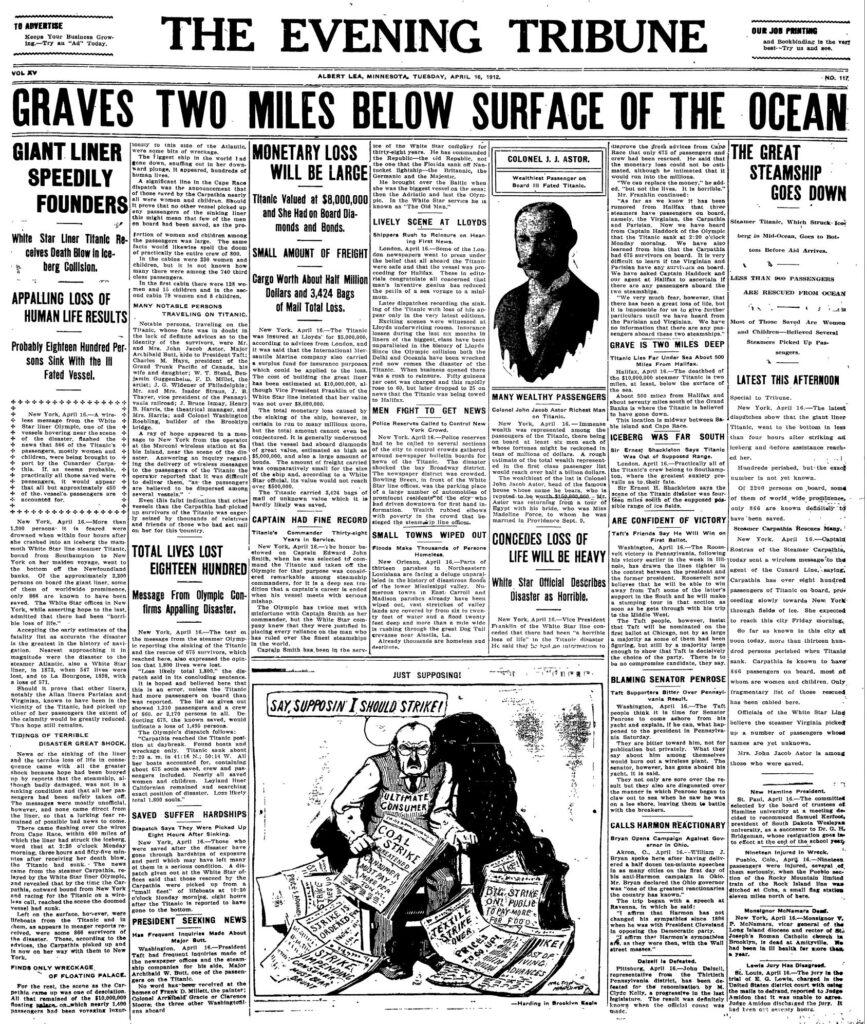
- Significant Loss of Life: The headline states that approximately 1,800 people perished when the Titanic sank, underscoring the massive loss of human life and the scale of the disaster.
- Financial Impact: The Titanic was valued at $8,000,000, including the cargo worth about half a million dollars, and carried a significant amount of diamonds and bonds. This highlights the substantial monetary loss alongside the human tragedy.
- Notable Passengers Lost: The page mentions the loss of many wealthy and notable passengers, including Colonel John Jacob Astor, emphasizing the broad impact of the disaster across different social strata and the prominence of some of its victims.
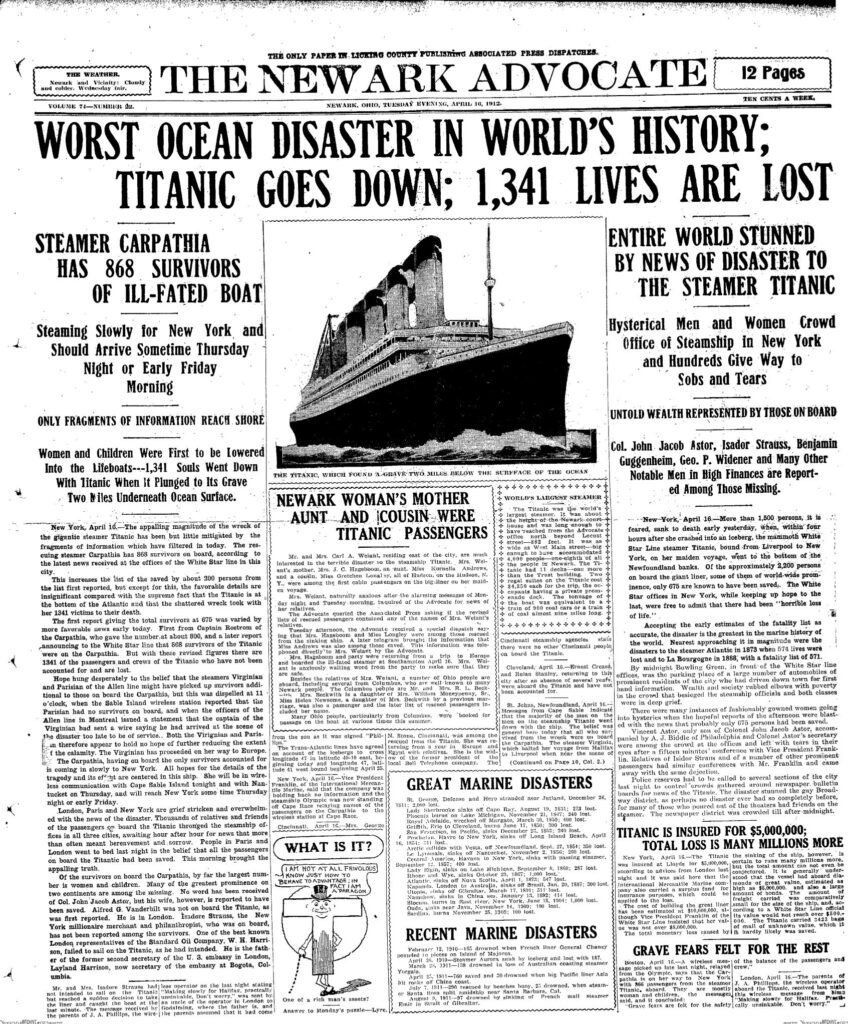
“Two regal suites on the Titanic cost $4,350 each for the trip, the occupants having a private promenade deck.”
The Newark Advocate, April 16, 1912
- Massive Loss of Life: The headline declares the Titanic disaster as the “Worst Ocean Disaster in World’s History,” reporting that 1,341 lives were lost when the ship sank, emphasizing the unprecedented scale of the tragedy.
- Survivors and Rescue Efforts: The Carpathia is reported to have 868 survivors from the ill-fated Titanic, with the ship steaming slowly toward New York and expected to arrive on Thursday night or early Friday morning. This underscores the ongoing efforts to bring the survivors to safety.
- Global Impact and Emotional Reactions: The article describes the entire world being stunned by the news of the disaster, with hysterical men and women crowding the offices of the steamship in New York, giving way to sobs and tears. It also notes the significant wealth represented by those on board, including prominent individuals like Col. John Jacob Astor and Isidor Straus.
“My God, my two brothers and my little daughter were on that ship. And I lost my wife and other child in the San Francisco earthquake. I had been waiting seven years for the return of my little girl and brothers.”
The New York Times, April 16, 1912
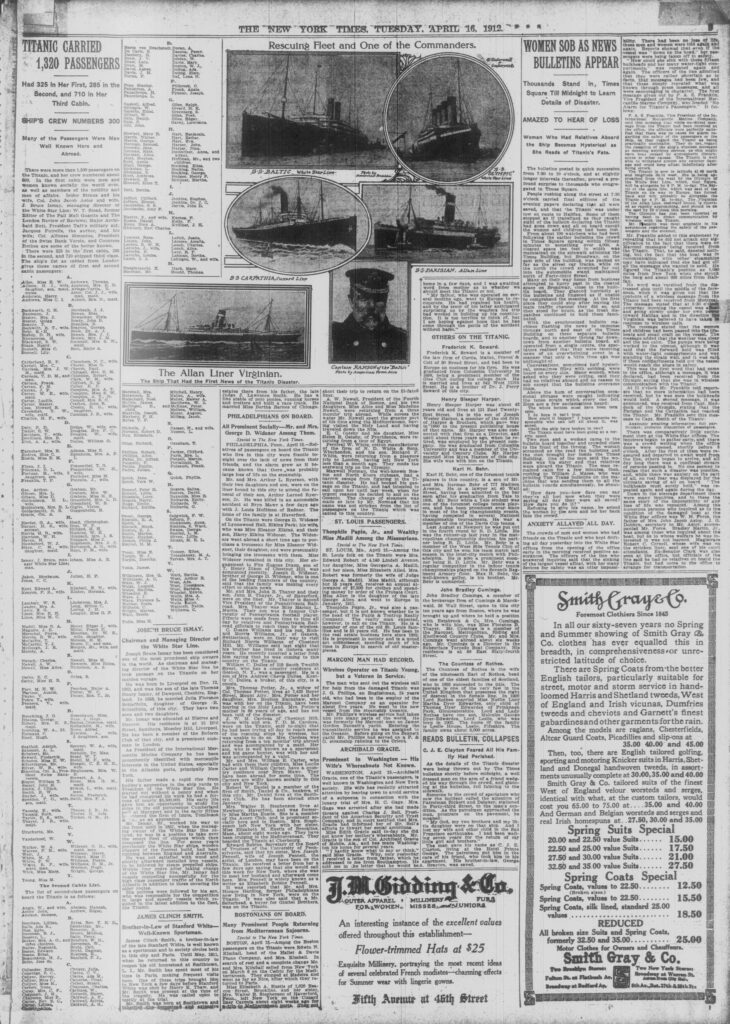
- Passenger and Crew Numbers: The Titanic carried 2,320 passengers, with specific breakdowns: 325 in first class, 285 in second class, and 710 in third class. The ship’s crew numbered 903, indicating the vast number of people affected by the disaster.
- Rescue Operations: The page features images and information about the rescuing fleet, including ships like the Carpathia and the Baltic, and one of the commanders, Captain Rostron of the Carpathia, who played a crucial role in the rescue efforts
- Public Reaction: The article describes women sobbing and thousands gathering in Times Square at midnight to learn details of the disaster, reflecting the emotional impact and widespread public interest in the fate of the Titanic and its passengers.
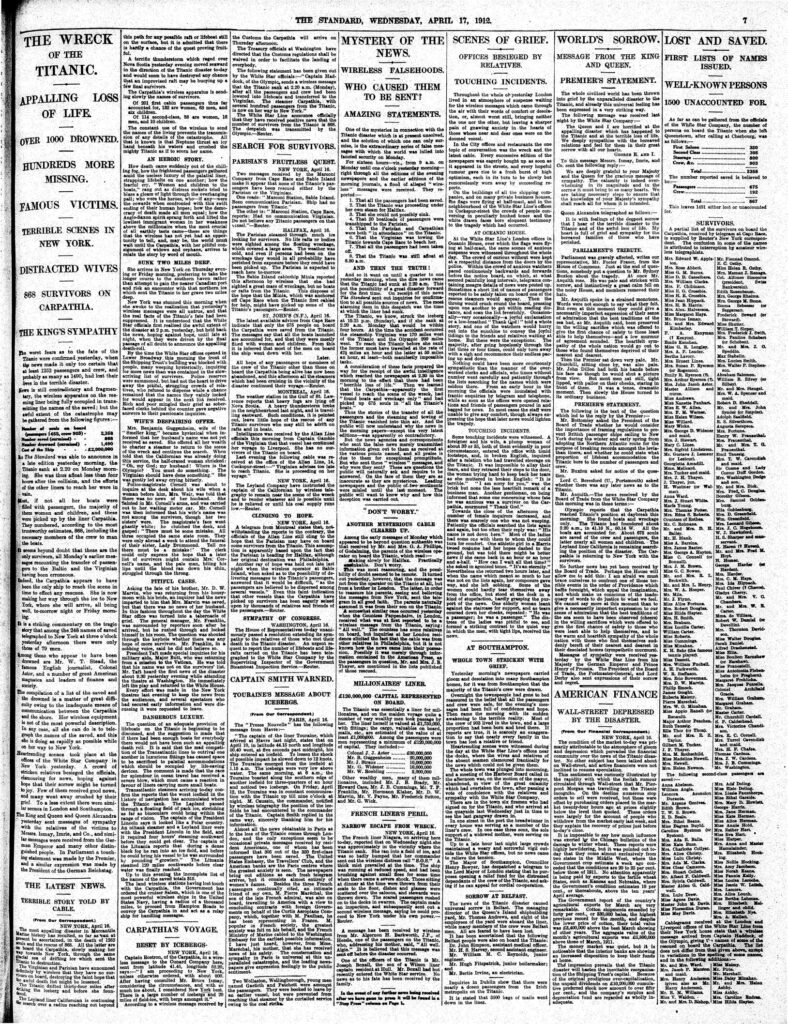
“One of the mysteries in connection with the Titanic disaster which is at present unsolved, and the solution of which one can only surmise, is the extraordinary series of false messages with which the world was lulled into fancied security on Monday.”
The Standard, April 17, 1912
- Appalling Loss of Life: The newspaper reports over 1,000 drowned and hundreds more missing, emphasizing the severe loss of life from the Titanic disaster.
- Famous Victims and Survivors: It mentions the presence of famous victims among the deceased and highlights that 868 survivors were rescued and brought to safety by the Carpathia.
- Scenes of Grief and World’s Sorrow: The article describes the overwhelming grief experienced by relatives of the victims, and the global sorrow felt, with messages of sympathy from prominent figures, including a message from the King and Queen.
“Somewhere in the Atlantic, pointed direct for this point, the Cunard liner Carpathia is speeding along as fast as her engines will drive her, bringing in the surviving 868 members of the passengers and crew of the White Star liner Titanic which sank early Monday morning, 800 miles off Newfoundland after her collision with an iceberg.”
The New York Times, April 17, 1912
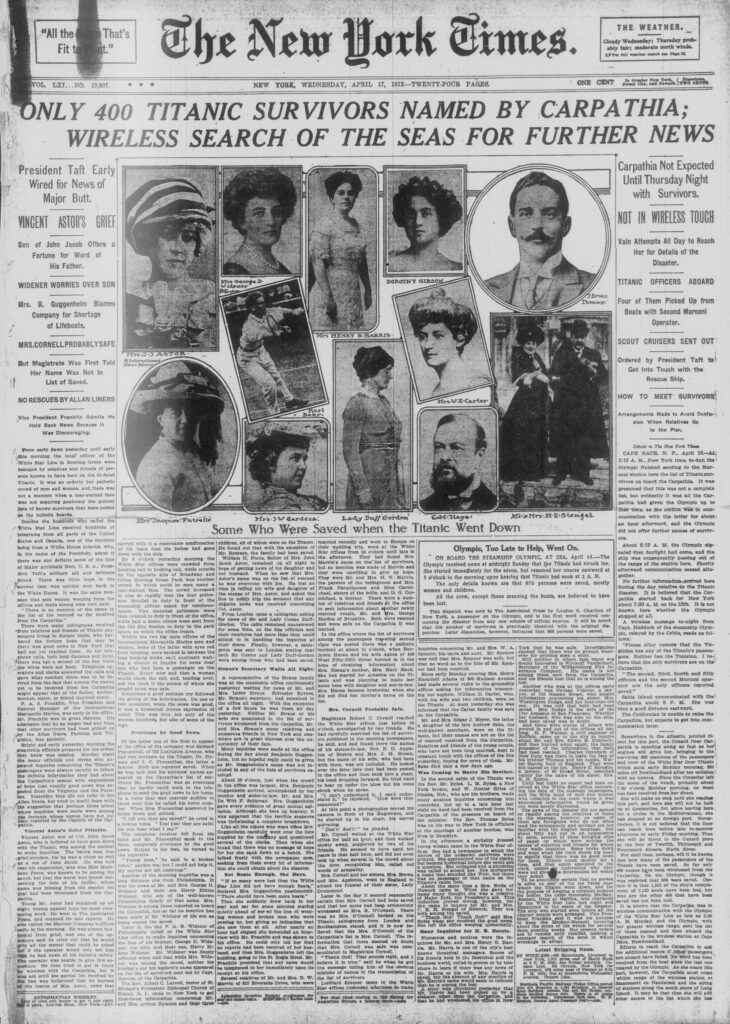
- Only 400 Survivors Named: The headline reports that only 400 Titanic survivors have been identified by the Carpathia, with ongoing wireless searches for further news. The Carpathia, carrying the survivors, is not expected to reach shore until Thursday night.
- High-Profile Passengers and Reactions: The article details the concerns of prominent individuals, such as President Taft, who wired for news of Major Butt, and Vincent Astor’s offer of a fortune for information about his father. It also includes the reactions of families and friends of other notable passengers.
- Rescue Efforts and Challenges: The page describes the rescue efforts, including the Carpathia’s role in picking up survivors and the challenges faced in communicating with the rescue ship. Additionally, it highlights President Taft’s order to send scout cruisers to establish contact with the Carpathia and assist in the rescue operations.
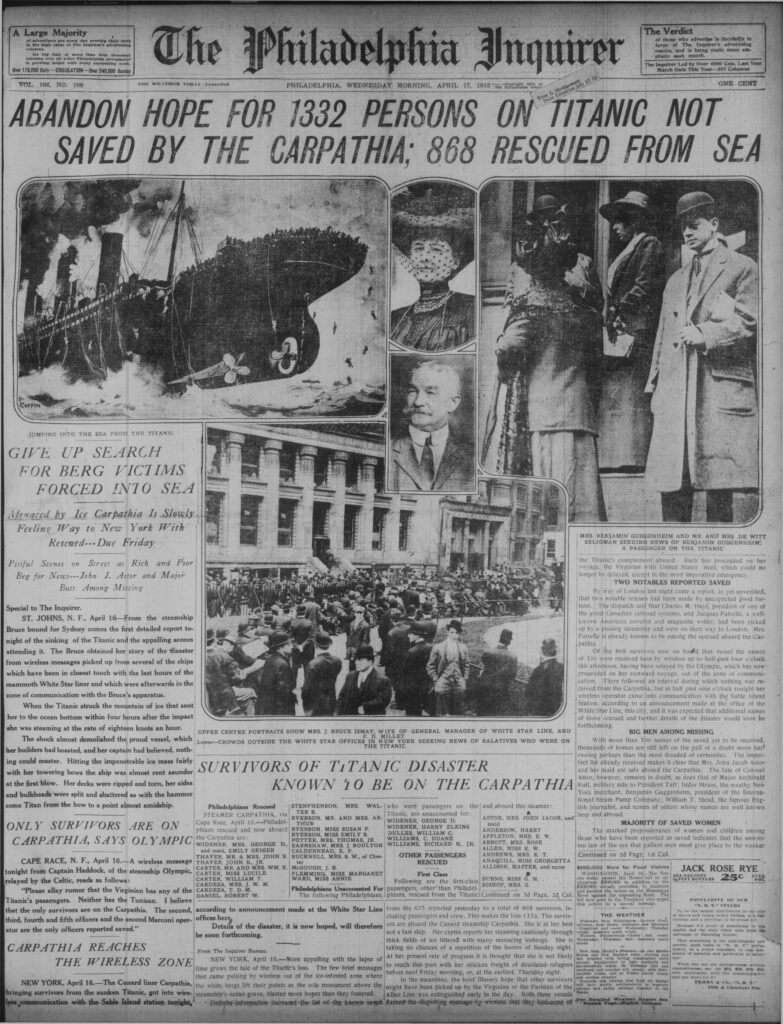
“Please allay rumor that the Virginian has any of the Titanic’s passengers. Neither has the Tunisan. I believe that the only survivors are on the Carpathia.”
The Philadelphia Inquirer, April 17, 1912
- Abandonment of Hope for Missing: The headline states that hope has been abandoned for 1,332 persons on the Titanic who were not saved by the Carpathia, emphasizing the scale of the loss.
- Survivors and Rescue Efforts: The page reports that 868 survivors were rescued from the sea by the Carpathia, highlighting the efforts of the rescue ship and the fortunate few who were saved.
- Prominent Figures and Public Reaction: The article features images and mentions of notable individuals such as Mrs. J. Bruce Ismay and Mrs. Astor, as well as descriptions of the public gathering at the White Star Line office in New York seeking news of their loved ones, illustrating the widespread impact and emotional response to the disaster.
“London, Paris and New York are overwhelmed by the news of the disaster. Tearful crowds of relatives and friends of passengers on board the Titanic thronged the steamship offices in all three cities, waiting hour after hour for news that more often than not when it does come means bereavement and sorry.”
The Daily Huronite, April 17, 1912
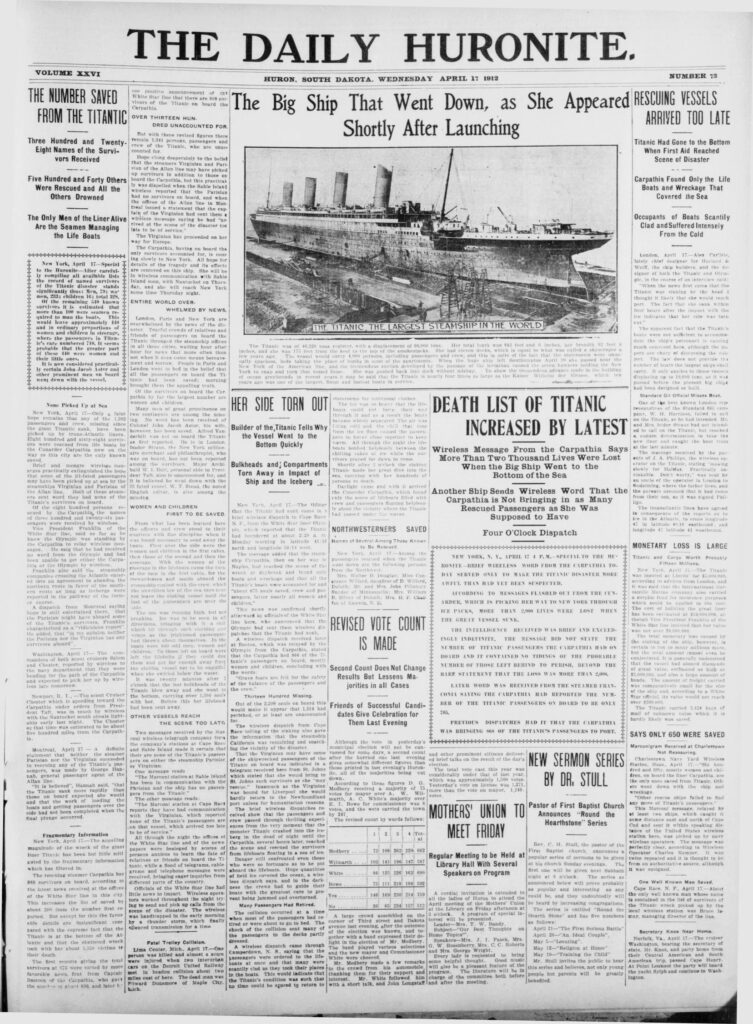
- Significant Loss of Life: The newspaper reports that more than 2,000 lives were lost when the Titanic went to the bottom of the sea, indicating an increase in the estimated death toll and underscoring the tragedy’s magnitude.
- Rescue Efforts and Outcomes: The Carpathia arrived at the disaster scene to find only lifeboats and wreckage, as the Titanic had already sunk. It rescued 320 survivors, including women and children, while emphasizing that all other occupants drowned.
- Ship’s Structural Failure: An explanation is provided by the Titanic’s builder, noting that the bulkheads and compartments were torn away by the impact of the ship with the iceberg, causing the vessel to sink quickly.
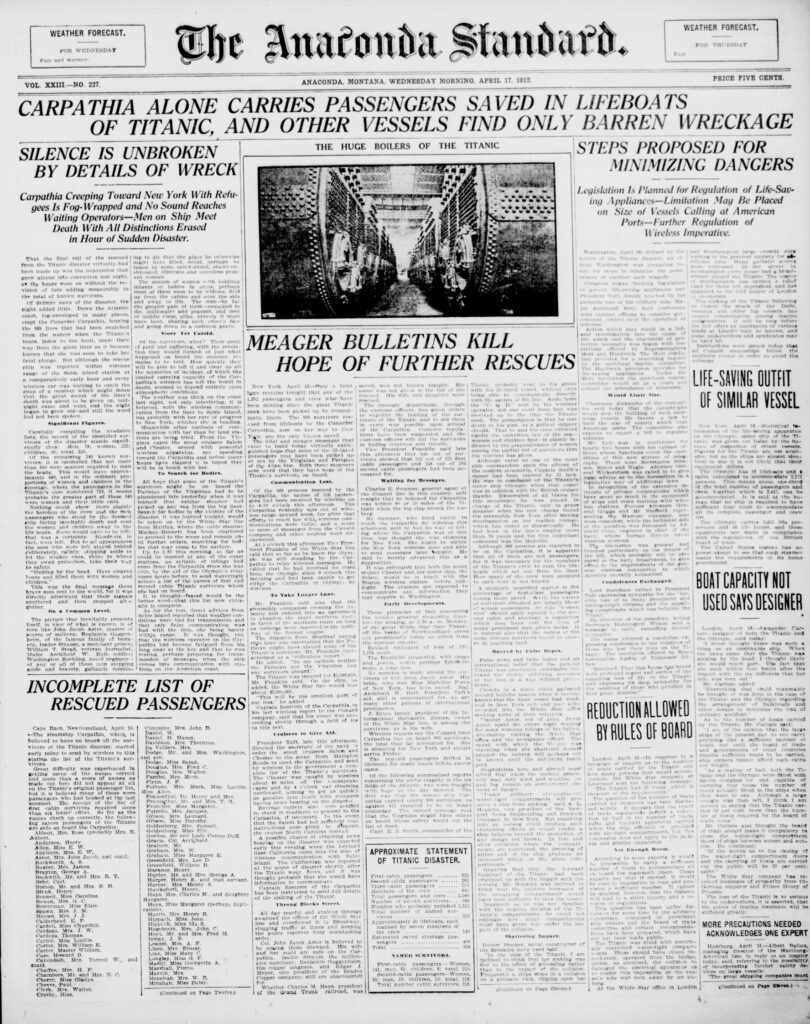
“I am of the opinion that the large ships of the present day do not carry anything like a sufficient number of boats.”
The Anaconda Standard, April 17, 1912
- Carpathia Alone Rescues Survivors: The Carpathia is reported as the sole ship carrying passengers saved in lifeboats from the Titanic, while other vessels find only barren wreckage, emphasizing the dire situation and the Carpathia’s crucial role in the rescue efforts.
- Silence and Despair: The page notes that silence is unbroken by details of the wreck, with the Carpathia creeping toward New York, shrouded in fog, and no sound reaching waiting operators. This conveys the sense of isolation and the desperate hope for news.
- Legislative Response and Safety Measures: In response to the disaster, steps are proposed for minimizing dangers, including legislation for the regulation of life-saving appliances and limitations on the size of vessels calling at American ports, highlighting the immediate call for improved safety standards.
“When the Titanic struck the mountain of ice that sent her to the ocean bottom within four hours after the impact, she was steaming at the rate of 18 knots an hour.”
https://newspaperarchive.com/baltimore-sun-apr-17-1912-p-1/The Sun, April 17, 1912
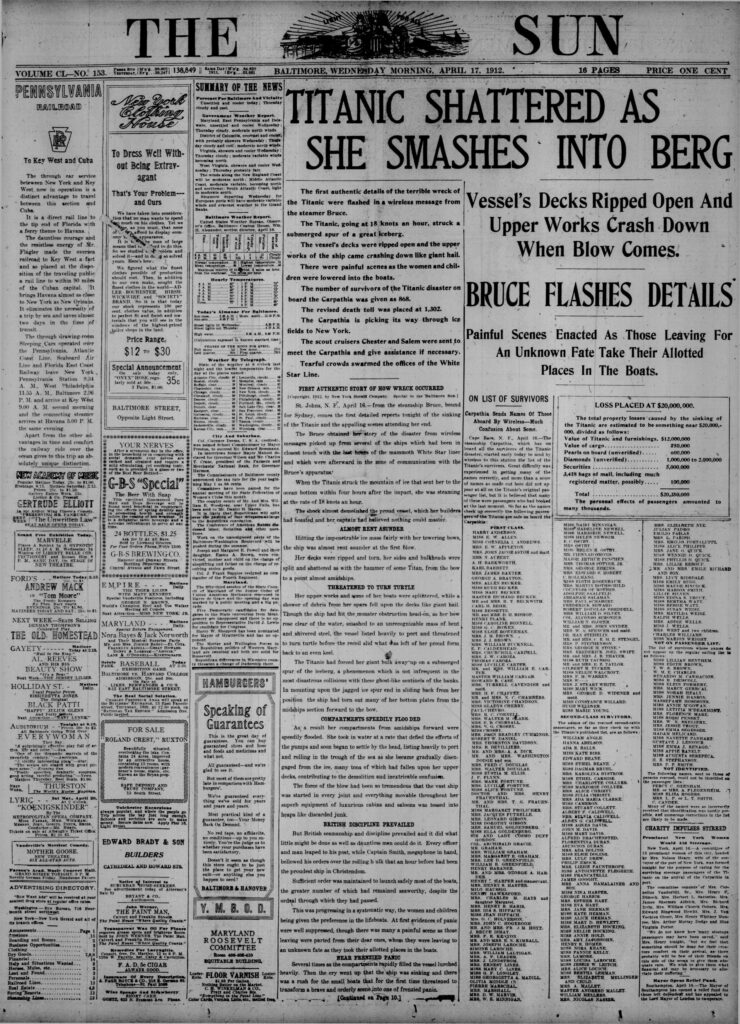
- Details of the Collision: The page describes the Titanic being shattered as it smashed into an iceberg at a speed of 21 knots, which ripped open the vessel’s decks and caused the upper works to crash down like giant hail, providing a vivid account of the physical damage caused by the collision.
- Death Toll and Rescue Efforts: The number of survivors on the Carpathia was revised to 868, and the death toll was placed at 1,302. The page also mentions that scout cruisers Chester and Salem were sent to meet the Carpathia and provide assistance, highlighting the efforts made to rescue and aid the survivors.
- Emotional Impact: The article details the painful scenes as passengers and crew took their allotted places in the lifeboats, knowing they were leaving for an unknown fate. It also mentions tearful crowds swarming the offices of the White Star Line, reflecting the widespread emotional impact of the disaster.
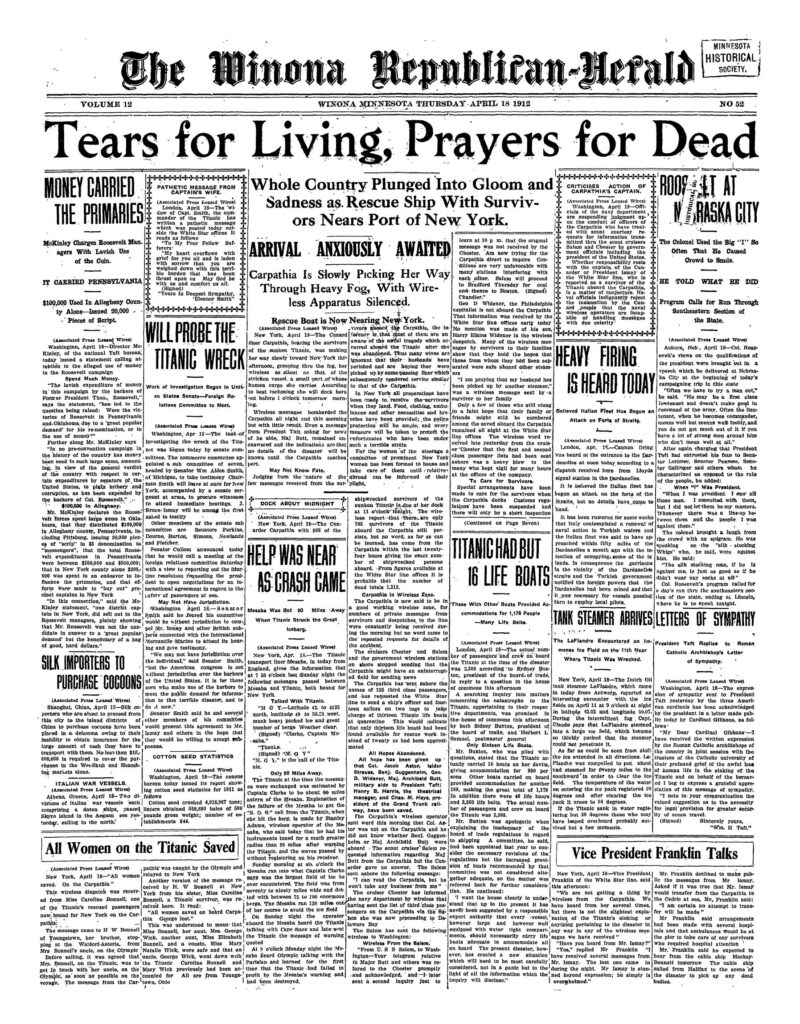
“To My Poor Fellow Sufferers. My heart overflows with grief for you all and is laden with sorrow that you are weighed down with this terrible burden that has been thrust upon us May God be with us and comfort us all. (Signed) Yours in Deepest Sympathy, Eleanor Smith”
The Winona Republican-Herald, April 18, 1912
- Nationwide Mourning: The headline “Tears for Living, Prayers for Dead” emphasizes the collective grief and mourning across the country as the rescue ship Carpathia, carrying Titanic survivors, nears the port of New York.
- Awaited Rescue and Investigation: The page mentions the anxious wait for the Carpathia’s arrival through heavy fog, as well as the ongoing investigation into the Titanic wreck, signaling the nation’s focus on both the immediate rescue efforts and understanding the disaster.
- Survivor and Lifeboat Accounts: Reports detail that help was near as the crash occurred, but the Titanic only had 16 lifeboats, far fewer than needed. This highlights the dire situation during the sinking and the lack of sufficient lifeboat capacity.
“Vincent Astor, son of Col. John Jacob Astor, started for Halifax, where he intends to charter a tug and go to the scene of the disaster to search for his father’s body.”
The Logansport Pharos, April 18, 1912
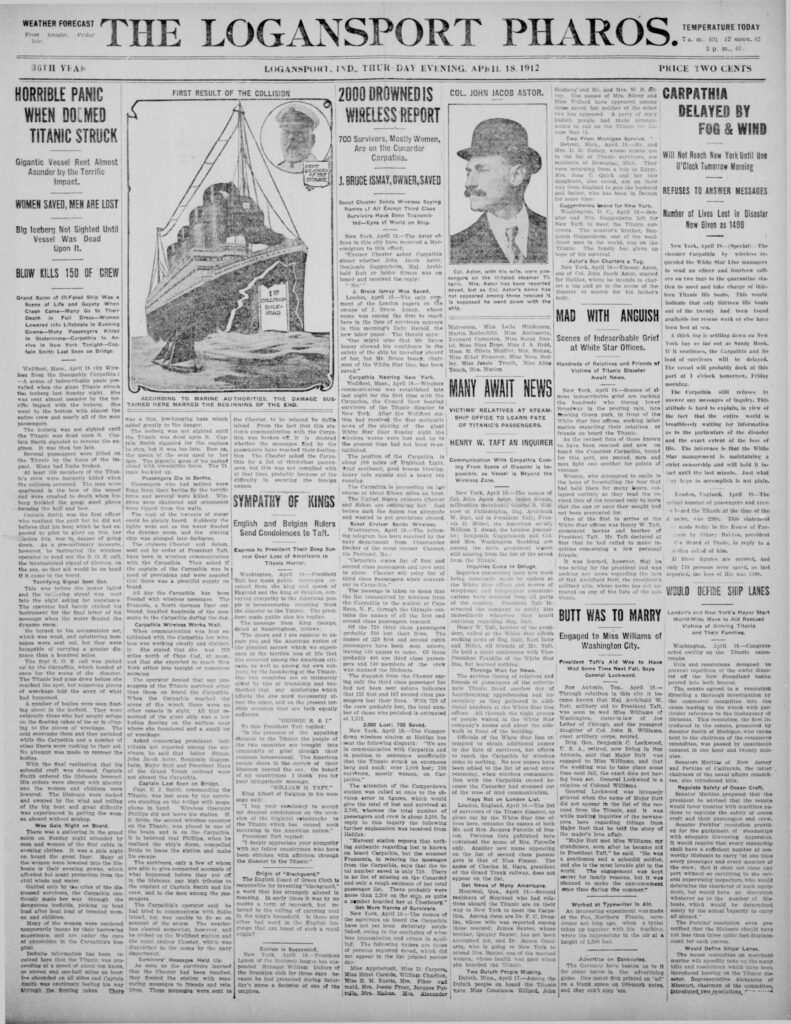
- Horrible Panic and Massive Loss of Life: The page reports a “horrible panic” when the Titanic struck the iceberg, with an estimated 2,000 drowned according to wireless reports. It highlights the chaos and high death toll, emphasizing the tragic nature of the disaster.
- Rescue Efforts and Delays: The Carpathia, carrying 700 survivors (mostly women), is delayed by fog and wind and will not reach New York until the following morning. The article also mentions that the Carpathia refuses to answer messages, adding to the tension and uncertainty.
- Notable Individuals and Emotional Impact: The page highlights notable individuals involved, such as J. Bruce Ismay, the owner of the Titanic, who was saved, and Colonel John Jacob Astor, who was lost. It also describes the scenes of anguish among those awaiting news of their loved ones, conveying the emotional toll of the tragedy.
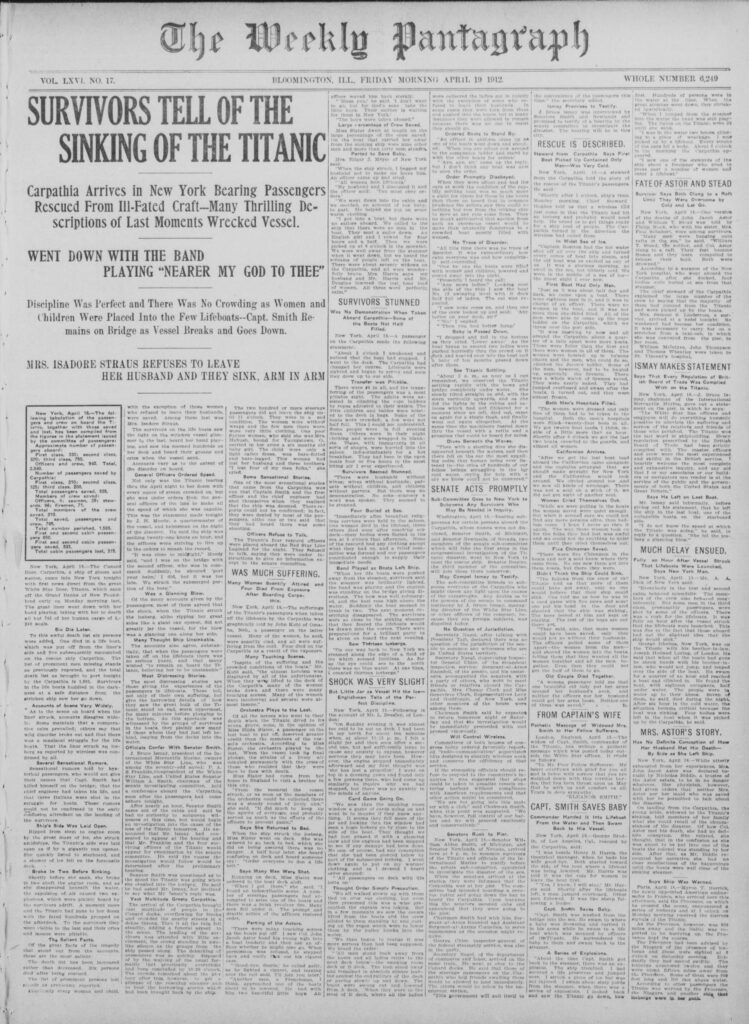
“Mrs. Isadore Straus refuses to leave her husband and they sink, arm in arm.”
The Weekly Pantagraph, April 19, 1912
- Survivor Accounts and Arrival: The headline emphasizes survivor stories, noting that the Carpathia arrived in New York carrying passengers rescued from the ill-fated Titanic, and provides many thrilling descriptions of the vessel’s final moments.
- Heroic Acts and Tragic Details: Noteworthy is the mention of discipline during the evacuation, with no crowding as women and children were placed in lifeboats. Capt. Smith stayed on the bridge as the vessel broke apart, and Mrs. Isadore Straus refused to leave her husband.
- Band’s Last Moments: The newspaper highlights the poignant detail that the ship’s band continued to play “Nearer My God to Thee” as the Titanic went down, a symbol of bravery and calm amid the chaos.
“E.Z. Taylor, of London, who was rescued from the Titanic, said that it appeared to him that the iceberg which sent the gigantic liner to its grave was about 80 feet in height.”
The Bradford Era, April 19, 1912
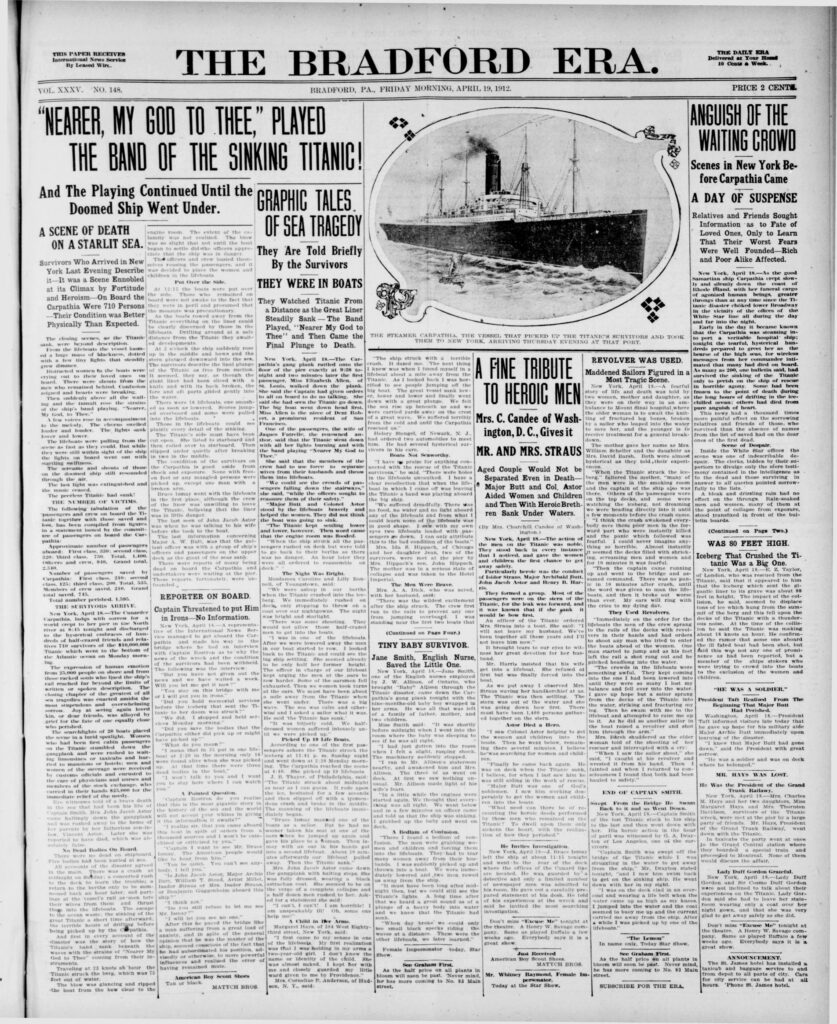
- Band’s Heroic Act: The headline emphasizes that the band played “Nearer, My God, to Thee” until the Titanic sank, highlighting a poignant and heroic detail of the disaster that underscored the courage and calm exhibited by some passengers and crew in the face of impending doom.
- Graphic Survivor Accounts: The newspaper includes graphic tales of the sea tragedy as told by survivors. These accounts describe scenes of death and chaos on a starlit sea, providing firsthand insights into the horror experienced by those who survived.
- Emotional Scenes in New York: The page describes the anguish of the waiting crowd in New York as the Carpathia arrived with survivors, detailing the emotional scenes of relatives and friends seeking information about their loved ones, and the mix of joy and grief as they learned the fates of the passengers.
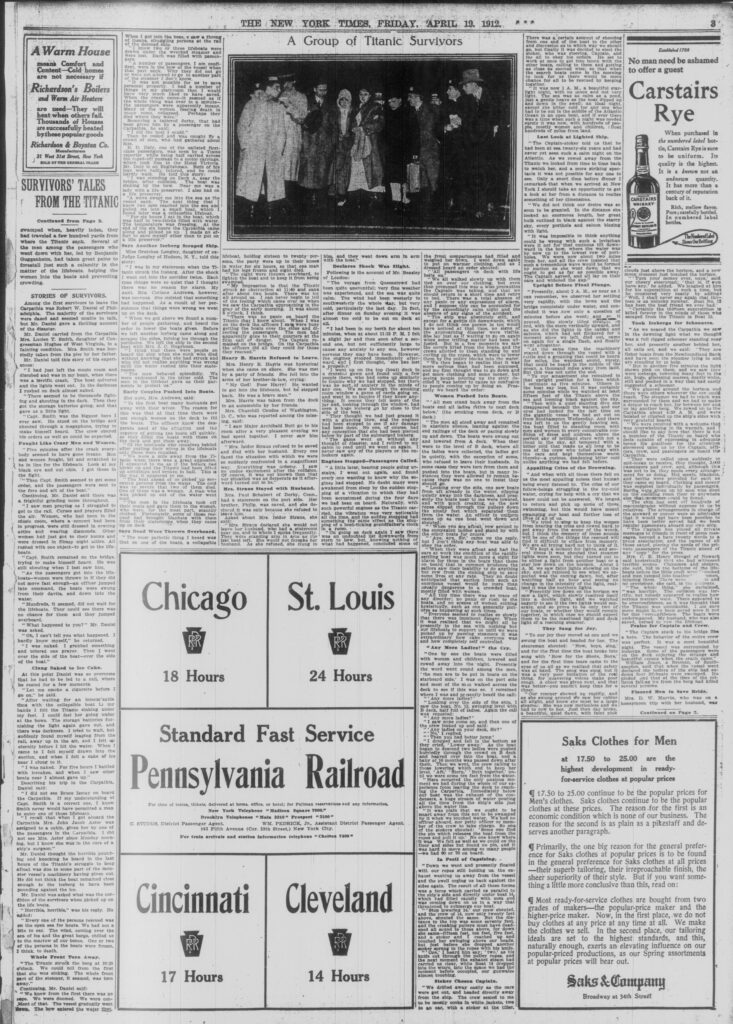
“For six hours I sat in the boat, which was half to two-thirds filled with water. The temperature was freezing.”
The New York Times, April 19, 1912
- Survivors’ Accounts: The page provides extensive survivor testimonies, detailing their harrowing experiences and the sequence of events as the Titanic sank. These personal stories give a vivid picture of the chaos and bravery during the disaster.
- Group Photo of Survivors: A significant photo on the page shows a group of Titanic survivors, illustrating the relief and emotional toll on those who made it through the ordeal. This visual element underscores the human impact of the tragedy.
- Heroic Efforts: The stories highlight the heroic efforts of individuals who assisted others during the evacuation, including those who ensured women and children were prioritized for lifeboats, reflecting the courage and selflessness displayed by many during the sinking.
“The most distressing picture of the disaster was the separation of men and their wives. Many of the wives, having kissed their husbands good-bye, still clung to them, refusing to get into the waiting life-boats. A great many men literally lifted their wives into the boats.”
The San Antonio Light, April 19, 1912
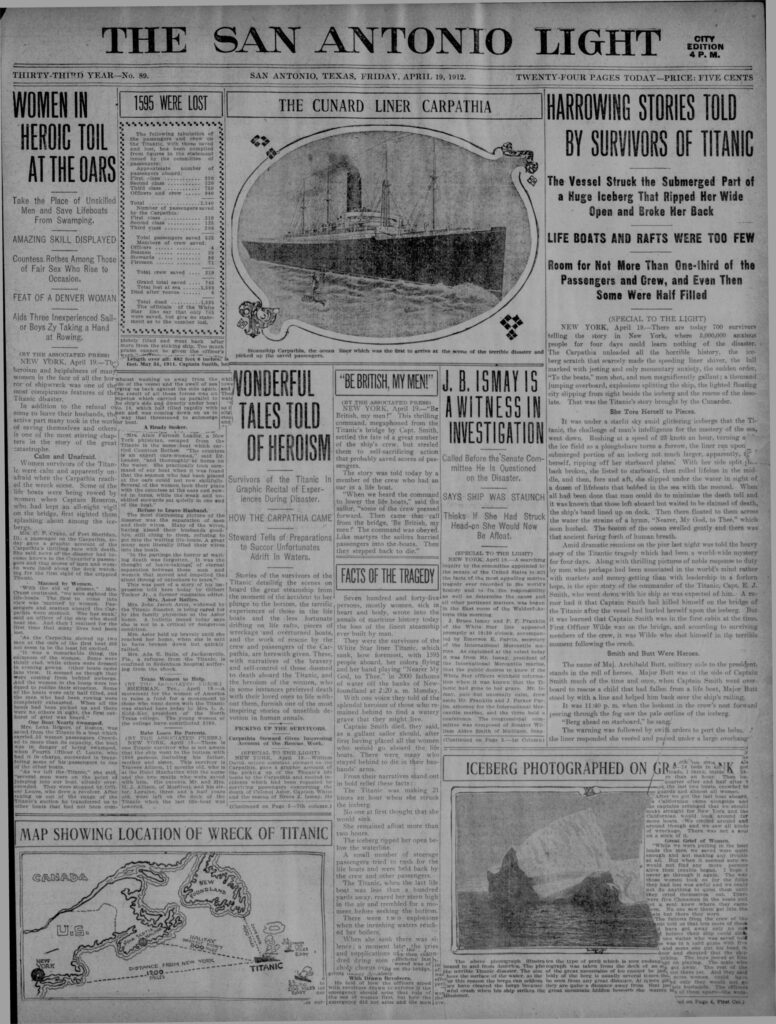
- High Death Toll: The page reports that 1,595 lives were lost in the disaster, underscoring the immense scale of the tragedy and the significant loss of life.
- Heroic Actions of Women: The article highlights the heroic efforts of women who took the place of unskilled men at the oars to row lifeboats to safety, showcasing their bravery and critical role in the rescue efforts.
- Insufficient Lifeboats: The survivors’ harrowing stories reveal that the Titanic had far too few lifeboats and rafts, providing room for only one-third of the passengers and crew, and even then, many lifeboats were only half-filled, indicating the inadequacy of safety measures on the ship.
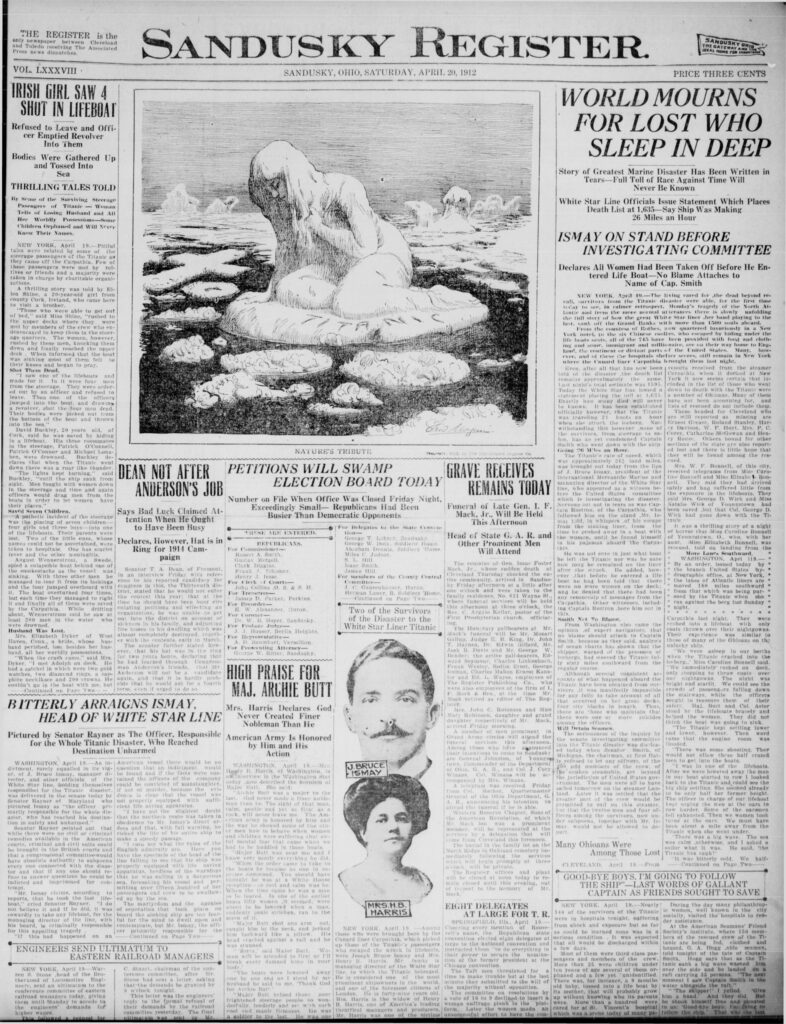
“G.A. Hogg able seaman, told tonight of the fate of Captain Smith. Hogg says that as the Titanic sank a big wave washed him over the side and he landed on a raft carry 35 persons. ‘The next moment I saw Captain Smith in the water alongside the raft. The skipper, I yelled. Give him a hand. And they did. But he shook himself free and shouted to us: Good-bye boys. I’m going to follow the ship.”
Sandusky Register, April 20, 1912
- Global Mourning: The headline “World Mourns for Lost Who Sleep in Deep” underscores the worldwide grief and sorrow following the Titanic disaster, emphasizing its impact on a global scale.
- Investigation and Accountability: J. Bruce Ismay, head of the White Star Line, is reported to be on the stand before the investigating committee, defending the actions taken and addressing the accusations of blame for the disaster.
- Harrowing Survivor Accounts: The article includes thrilling and tragic tales from survivors, such as the account of an Irish girl who saw four men shut in a lifeboat and refused to leave, highlighting the bravery and traumatic experiences of those who lived through the sinking.
“Rescued girl a bride. Titanic survivor came from England to join fiancé.”
The Sun, April 22, 1912
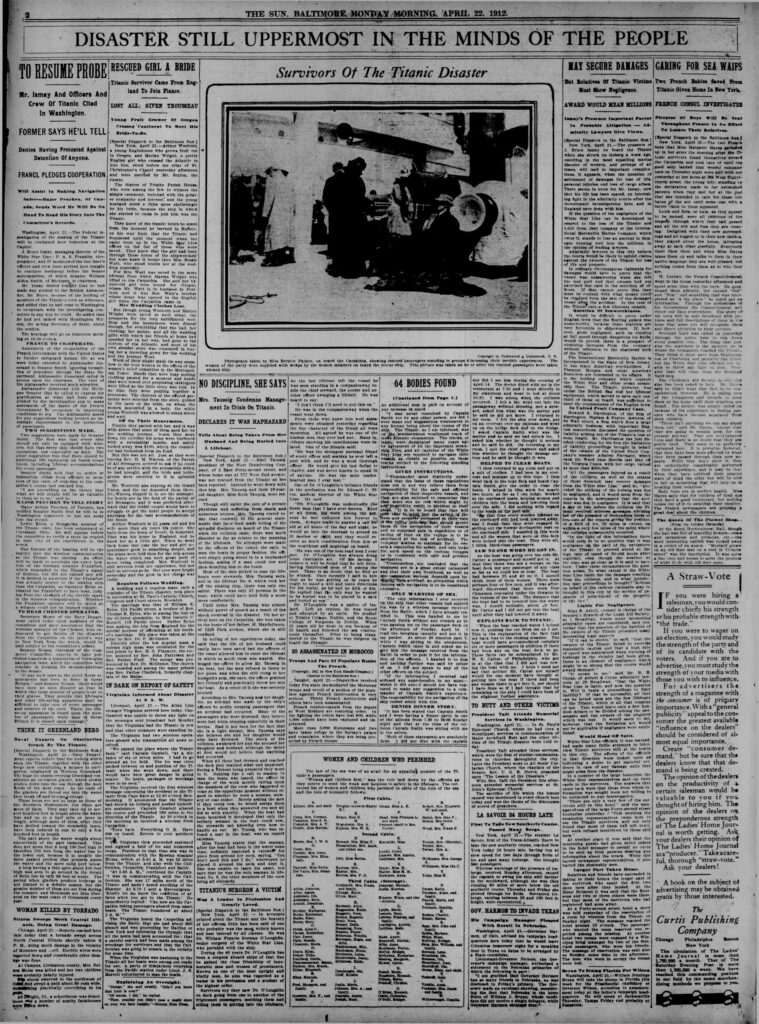
- Ongoing Investigation and Testimonies: The page mentions that Mr. Ismay and officers from the Titanic’s crew are to resume their testimonies in Washington, emphasizing the continued investigation into the disaster and the search for accountability.
- Survivors’ Harrowing Experiences: It features personal accounts from survivors, including a rescued girl and a bride, providing firsthand descriptions of their traumatic experiences and the chaos during the sinking.
- Recovery Efforts: The article reports that 64 bodies have been found, detailing the grim recovery operations and the ongoing efforts to locate and identify victims, reflecting the extensive impact and aftermath of the disaster.
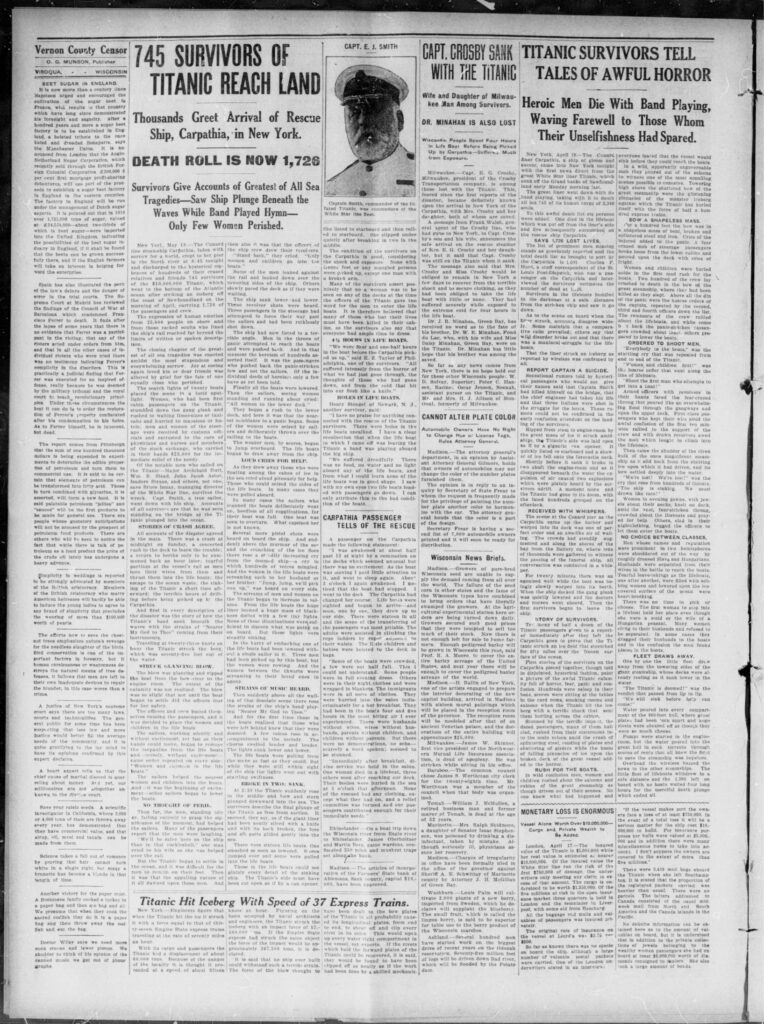
“We were four and one-half hours in the boat before the Carpathia picked us up…all suffered intensely from the horror of what we had just gone through, the thoughts of those who had done down, and from the cold that bit into our flesh like a knife.”
Vernon County Censor, April 24, 1912
- Arrival of Survivors: The page reports that 745 survivors of the Titanic have reached land aboard the rescue ship Carpathia in New York, bringing attention to the immediate aftermath and the ongoing relief efforts.
- Rising Death Toll: It is noted that the death toll from the disaster has now reached 1,728, underscoring the extensive loss of life and the scale of the tragedy.
- Heroic and Harrowing Accounts: Survivors share tales of bravery and horror, including heroic men who died with the band playing and those who faced unimaginable challenges during the sinking, providing personal insights into the disaster’s human impact.
“Now that the first shock of the Titanic disaster, with the succession of wild rumors which it brought, has given place to something like certain knowledge of what occurred on the terrible night that the giant liner plunged to the bottom of the sea, the following complete narrative of the wreck, with the events that preceded and followed it, is rendered most timely. With its swift alternations of scenes of horror and heroism, of grim struggles for life and awful sufferings, it is probably the most dramatic true story of the sea ever written. It is printed at the request of many TIMES readers.”
The New York Times, April 28, 1912
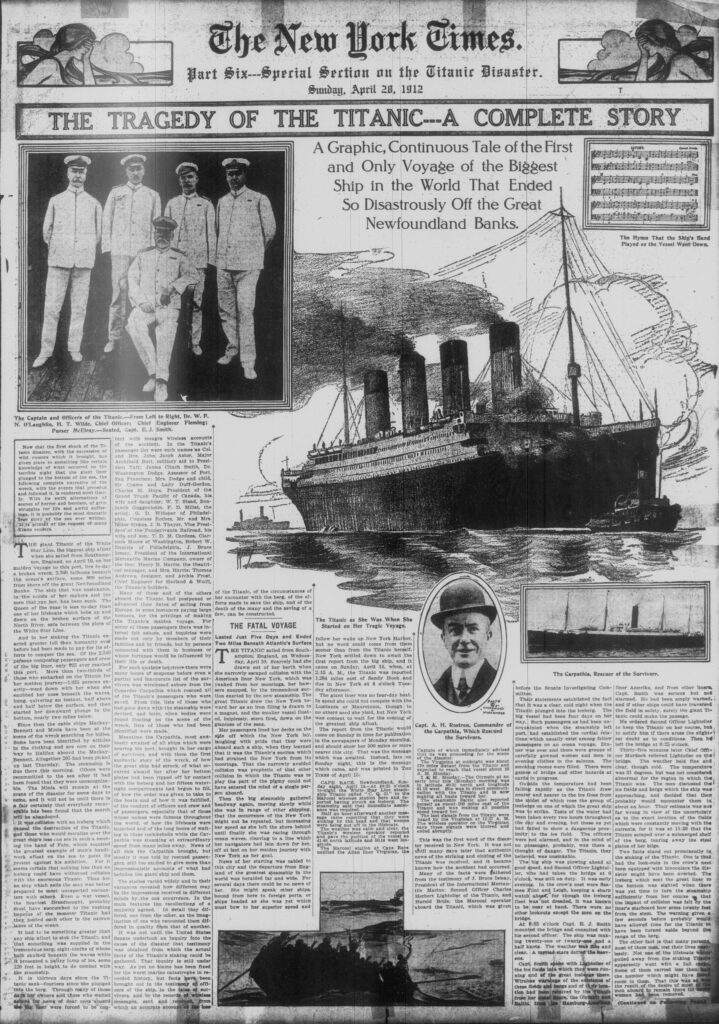
- Comprehensive Story of the Titanic’s Tragic Voyage: The page presents a detailed account of the Titanic’s first and only voyage, highlighting it as the largest ship in the world at the time and describing its disastrous end off the Great Newfoundland Banks.
- Visual and Personal Elements: The newspaper features images of the ship, the officers, and the captain of the rescue ship Carpathia, adding a personal and visual dimension to the story, making the tragedy more tangible to readers.
- Impactful Headlines and Descriptions: The page includes impactful headlines such as “THE TRAGEDY OF THE TITANIC—A COMPLETE STORY” and “THE FATAL VOYAGE,” which capture the scale and emotional weight of the disaster, emphasizing its significance in maritime history.
The sinking of the Titanic remains one of the most captivating and tragic events in maritime history. Through these newspaper archives, we’ve glimpsed the shock, sorrow, and heroism that unfolded in April 1912. From initial confusion to heartbreaking realizations, from tales of sacrifice to accounts of survival against all odds, these historic pages paint a vivid picture of a disaster that shook the world.
The Titanic’s story continues to resonate over a century later, reminding us of human fragility in the face of nature, the importance of safety measures, and the extraordinary courage people can display in dire circumstances. For genealogists and history enthusiasts alike, these accounts offer invaluable insights into the era and the profound impact this event had on individuals, families, and society as a whole.
As we reflect on these poignant newspaper reports, we’re reminded that behind every headline and statistic were real people with hopes, dreams, and loved ones waiting for news. The Titanic’s legacy lives on, not just as a cautionary tale, but as a testament to human resilience and the enduring power of memory.